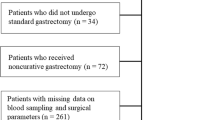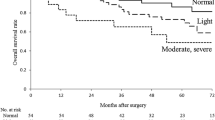Abstract
Background
Preoperative nutritional assessment of cancer patients is important to reduce postoperative complications. Several studies have reported the Geriatric Nutritional Risk Index (GNRI) to be useful in assessing underlying diseases and long-term outcomes of hospitalized patients. The present study aimed to evaluate the impact of preoperative GNRI on short- and long-term outcomes in elderly gastric cancer patients who underwent laparoscopic gastrectomy.
Methods
We retrospectively reviewed consecutive patients aged ≥ 65 years who underwent laparoscopy-assisted gastrectomy and had R0 resection for histologically confirmed gastric adenocarcinoma. The cutoff value for preoperative GNRI was determined to be 85.7 based on the incidence of postoperative complications. Patients were categorized into two groups: low GNRI group and normal GNRI group.
Results
Univariate analyses of the 303 patients revealed that the incidence of postoperative complications was significantly associated with the American Society of Anesthesiologists Physical Status classification (ASA-PS), C-reactive protein (CRP), GNRI (p < 0.001), and operative procedure. Multivariate analyses revealed that preoperative GNRI (odds ratio [OR] 2.716; 95% confidence interval [CI] 1.166–6.328; p = 0.021) and operative procedure (OR 2.459; 95% CI 1.378–4.390; p = 0.002) were independently associated with the incidence of postoperative complications.
Univariate analyses showed that overall survival (OS) was significantly associated with ASA-PS, tumor size, tumor differentiation, pathological tumor node metastasis (TNM) stage, carcinoembryonic antigen (CEA), CRP, GNRI, and postoperative complications. Multivariate analysis demonstrated that ASA-PS (hazard ratio [HR], 3.755; 95% CI 2.141–6.585; p < 0.001), tumor differentiation (HR 1.898; 95% CI 1.191–3.025; p = 0.007), CEA (HR 1.645; 95% CI 1.024–2.643; p = 0.040), and GNRI (HR 2.093; 95% CI 1.105–3.963; p = 0.023) independently predicted OS.
Conclusion
GNRI is an important predictor of postoperative complications and overall survival in elderly gastric cancer patients. It is a reliable and cost-effective prognostic indicator that should be routinely evaluated.



Similar content being viewed by others
References
Laky B, Janda M, Kondalsamy-Chennakesavan S, Cleghorn G, Obermair A (2010) Pretreatment malnutrition and quality of life - association with prolonged length of hospital stay among patients with gynecological cancer: a cohort study. BMC Cancer 25(10):232. https://doi.org/10.1186/1471-2407-10-232
Ho JW, Wu AH, Lee MW, Lau SY, Lam PS, Lau WS, Kwok SS, Kwan RY, Lam CF, Tam CK, Lee SO (2015) Malnutrition risk predicts surgical outcomes in patients undergoing gastrointestinal operations: results of a prospective study. Clin Nutr 34(4):679–684. https://doi.org/10.1016/j.clnu.2014.07.012
Fujiya K, Kawamura T, Omae K, Makuuchi R, Irino T, Tokunaga M, Tanizawa Y, Bando E, Terashima M (2018) Impact of malnutrition after gastrectomy for gastric cancer on long-term survival. Ann Surg Oncol 25(4):974–983. https://doi.org/10.1245/s10434-018-6342-8
Bouillanne O, Morineau G, Dupont C, Coulombel I, Vincent JP, Nicolis I, Benazeth S, Cynober L, Aussel C (2005) Geriatric Nutritional Risk Index: a new index for evaluating at-risk elderly medical patients. Am J Clin Nutr 82(4):777–783
Abd-El-Gawad WM, Abou-Hashem RM, El Maraghy MO, Amin GE (2014) The validity of Geriatric Nutrition Risk Index: simple tool for prediction of nutritional-relatedcomplication of hospitalized elderly patients. Comparison with Mini Nutritional Assessment. Clin Nutr 33(6):1108–1116. https://doi.org/10.1016/j.clnu.2013.12.005
Sze S, Zhang J, Pellicori P, Morgan D, Hoye A, Clark AL (2017) Prognostic value of simple frailty and malnutrition screening tools in patients with acute heart failure due to left ventricular systolic dysfunction. Clin Res Cardiol 106(7):533–541. https://doi.org/10.1007/s00392-017-1082-5
Wang H, Hai S, Zhou Y, Liu P, Dong BR (2018) The Geriatric Nutritional Risk Index predicts mortality in nonagenarians and centenarians receiving home care. Asia Pac J Clin Nutr 27(1):78–83. https://doi.org/10.6133/apjcn.022017.10
Yamana I, Takeno S, Shibata R, Shiwaku H, Maki K, Hashimoto T, Shiraishi T, Iwasaki A, Yamashita Y (2015) Is the geriatric nutritional risk index a significant predictor of postoperative complications in patients with esophageal cancer undergoing esophagectomy? Eur Surg Res 55(1–2):35–42. https://doi.org/10.1159/000376610
Kubo N, Sakurai K, Tamura T, Toyokawa T, Tanaka H, Muguruma K, Yashiro M, Ohira M (2019) The impact of geriatric nutritional risk index on surgical outcomes after esophagectomy in patients with esophageal cancer. Esophagus 16(2):147–154. https://doi.org/10.1007/s10388-018-0644-6
Funamizu N, Nakabayashi Y, Iida T, Kurihara K (2018) Geriatric nutritional risk index predicts surgical site infection after pancreaticoduodenectomy. Mol Clin Oncol 9(3):274–278. https://doi.org/10.3892/mco.2018.1671
Gertsen EC, Brenkman HJF, Seesing MFJ, Goense L, Ruurda JP, van Hillegersberg R, Audit DUGC, (DUCA) Group (2019) Introduction of minimally invasive surgery for distal and total gastrectomy: a population-based study. Eur J Surg Oncol 45(3):403–409. https://doi.org/10.1016/j.ejso.2018.08.015
Sawazaki S, Numata M, Morita J, Maezawa Y, Amano S, Aoyama T, Tamagawa H, Sato T, Oshima T, Mushiake H, Yukawa N, Shiozawa M, Rino Y, Masuda M (2018) Safety of laparoscopic surgery for colorectal cancer in patients with severe comorbidities. Anticancer Res 38(6):3767–3772. https://doi.org/10.21873/anticanres.12659
Isani MA, Schlieve C, Jackson J, Elizee M, Asuelime G, Rosenberg D, Kim ES (2018) Is less more? Laparoscopic versus open Ladd's procedure in children with malrotation. J Surg Res 229:351–356. https://doi.org/10.1016/j.jss.2018.04.016
Yoshida K, Honda M, Kumamaru H, Kodera Y, Kakeji Y, Hiki N, Etoh T, Miyata H, Yamashita Y, Seto Y, Kitano S, Konno H (2017) Surgical outcomes of laparoscopic distal gastrectomy compared to open distal gastrectomy: a retrospective cohort study based on a nationwide registry database in Japan. Ann Gastroenterol Surg 2(1):55–64. https://doi.org/10.1002/ags3.12054
Japanese Gastric Cancer Association (2017) Japanese gastric cancer treatment guidelines 2014 (ver. 4). Gastric Cancer 20(1):1–19. https://doi.org/10.1007/s10120-016-0622-4
Sobin L, Gospodarowicz M, Wittekind C (eds) (2010) International Union against Cancer (UICC). TNM classification of malignant tumors, 7th edn. Wiley-Blackwell, New York
Clavien PA, Barkun J, de Oliveira ML, Vauthey JN, Dindo D, Schulick RD, de Santibañes E, Pekolj J, Slankamenac K, Bassi C, Graf R, Vonlanthen R, Padbury R, Cameron JL, Makuuchi M (2009) The Clavien-Dindo classification of surgical complications: five-year experience. Ann Surg 250(2):187–196. https://doi.org/10.1097/SLA.0b013e3181b13ca2
Matsumura T, Mitani Y, Oki Y, Fujimoto Y, Ohira M, Kaneko H, Kawashima T, Nishio M, Ishikawa A (2015) Comparison of Geriatric Nutritional Risk Index scores on physical performance among elderly patients with chronic obstructive pulmonary disease. Heart Lung 44(6):534–538. https://doi.org/10.1016/j.hrtlng.2015.08.004
Kuo IC, Huang JC, Wu PY, Chen SC, Chang JM, Chen HC (2017) A low geriatric nutrition risk index is associated with progression to dialysis in patients with chronic kidney disease. Nutrients. https://doi.org/10.3390/nu9111228
Wada H, Dohi T, Miyauchi K, Doi S, Naito R, Konishi H, Tsuboi S, Ogita M, Kasai T, Hassan A, Okazaki S, Isoda K, Suwa S, Daida H (2017) Prognostic impact of the geriatric nutritional risk index on long-term outcomes in patients who underwent percutaneous coronary intervention. Am J Cardiol 119(11):1740–1745. https://doi.org/10.1016/j.amjcard.2017.02.051
Abd-El-Gawad WM, Abou-Hashem RM, El Maraghy MO, Amin GE (2014) The validity of Geriatric Nutrition Risk Index: simple tool for prediction of nutritional-related complication of hospitalized elderly patients. Comparison with Mini Nutritional Assessment. Clin Nutr 33(6):1108–1116. https://doi.org/10.1016/j.clnu.2013.12.005
Poziomyck AK, Weston AC, Lameu EB, Cassol OS, Coelho LJ, Moreira LF (2012) Preoperative nutritional assessment and prognosis in patients with foregut tumors. Nutr Cancer 64(8):1174–1181. https://doi.org/10.1080/01635581.2012.721157
Lai CC, You JF, Yeh CY, Chen JS, Tang R, Wang JY, Chin CC (2011) Low preoperative serum albumin in colon cancer: a risk factor for poor outcome. Int J Colorectal Dis 26(4):473–481. https://doi.org/10.1007/s00384-010-1113-4
Ri M, Miyata H, Aikou S, Seto Y, Akazawa K, Takeuchi M, Matsui Y, Konno H, Gotoh M, Mori M, Motomura N, Takamoto S, Sawa Y, Kuwano H, Kokudo N (2015) Effects of body mass index (BMI) on surgical outcomes: a nationwide survey using a Japanese web-based database. Surg Today 45(10):1271–1279. https://doi.org/10.1007/s00595-015-1231-2
Chen L, Hasni MS, Jondal M, Yakimchuk K (2017) Modification of anti-tumor immunity by tolerogenic dendritic cells. Autoimmunity 50(6):370–376. https://doi.org/10.1080/08916934.2017.1344837
Bárta I, Smerák P, Polívková Z, Sestáková H, Langová M, Turek B, Bártová J (2006) Current trends and perspectives in nutrition and cancer prevention. Neoplasma 53(1):19–25
Márton S, Garai J, Molnár V, Juhász V, Bogár L, Köszegi T, Falusi B, Ghosh S (2011) Kinetics of inflammatory markers following cancer-related bowel and liver resection. Ups J Med Sci 116(2):124–128. https://doi.org/10.3109/03009734.2010.519446
Krzystek-Korpacka M, Matusiewicz M, Diakowska D, Grabowski K, Blachut K, Kustrzeba-Wojcicka I, Terlecki G, Gamian A (2008) Acute-phase response proteins are related to cachexia and accelerated angiogenesis in gastroesophageal cancers. Clin Chem Lab Med 46(3):359–364. https://doi.org/10.1515/CCLM.2008.089
Antonelli M, Kushner I (2017) It's time to redefine inflammation. FASEB J 31(5):1787–1791. https://doi.org/10.1096/fj.201601326R
Patterson BM, Cornell CN, Carbone B, Levine B, Chapman D (1992) Protein depletion and metabolic stress in elderly patients who have a fracture of the hip. J Bone Joint Surg Am 74(2):251–260
Shoji F, Matsubara T, Kozuma Y, Haratake N, Akamine T, Takamori S, Katsura M, Toyokawa G, Okamoto T, Maehara Y (2019) Relationship between preoperative sarcopenia status and immuno-nutritional parameters in patients with early-stage non-small cell lung cancer. Anticancer Res 37(12):6997–7003
Funding
This study received no external funding.
Author information
Authors and Affiliations
Corresponding author
Ethics declarations
Disclosures
Drs. Noriyuki Hirahara, Yoshitsugu Tajima, Yusuke Fujii, Shunsuke Kaji, Tetsu Yamamoto, Ryoji Hyakudomi, Takahito Taniura, and Yasunari Kawabata have no conflicts of interest or financial ties to disclose.
Additional information
Publisher's Note
Springer Nature remains neutral with regard to jurisdictional claims in published maps and institutional affiliations.
Rights and permissions
About this article
Cite this article
Hirahara, N., Tajima, Y., Fujii, Y. et al. Prediction of postoperative complications and survival after laparoscopic gastrectomy using preoperative Geriatric Nutritional Risk Index in elderly gastric cancer patients. Surg Endosc 35, 1202–1209 (2021). https://doi.org/10.1007/s00464-020-07487-7
Received:
Accepted:
Published:
Issue Date:
DOI: https://doi.org/10.1007/s00464-020-07487-7




